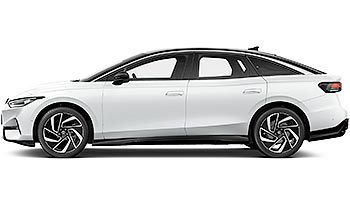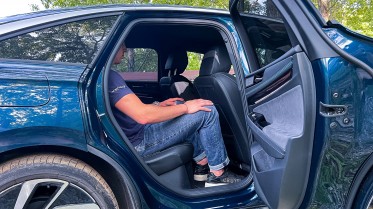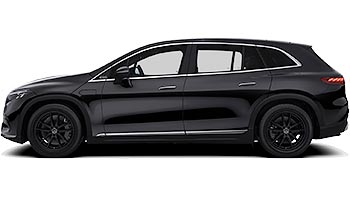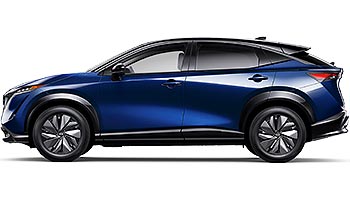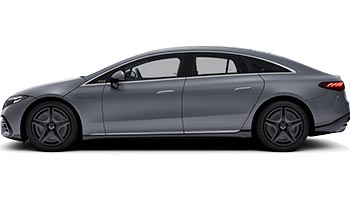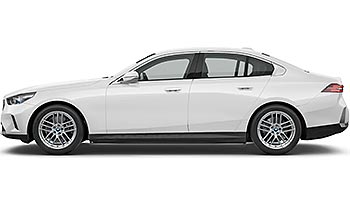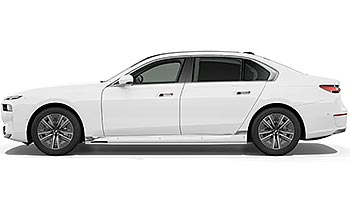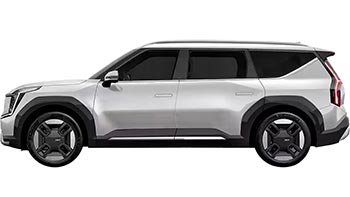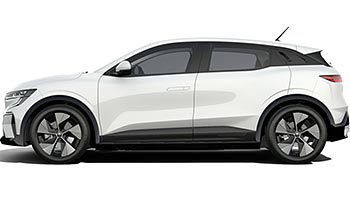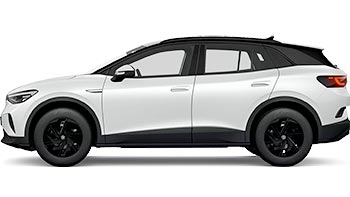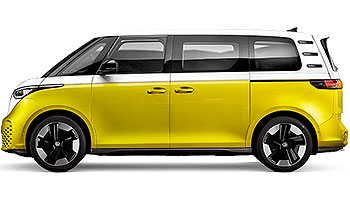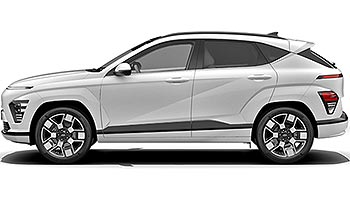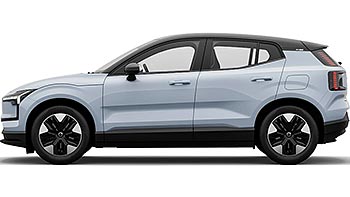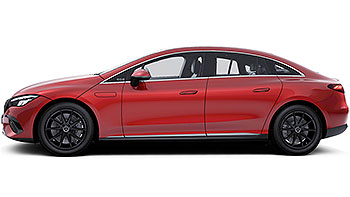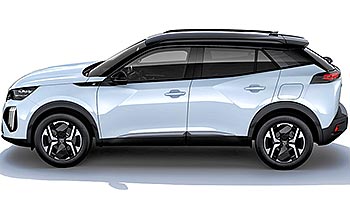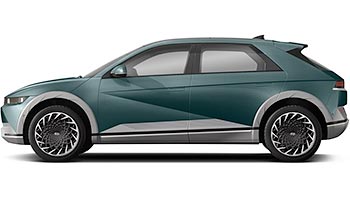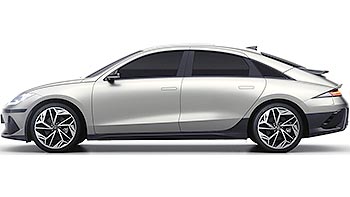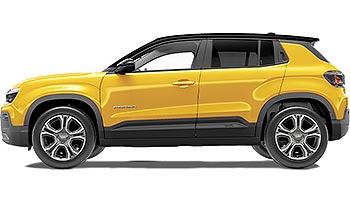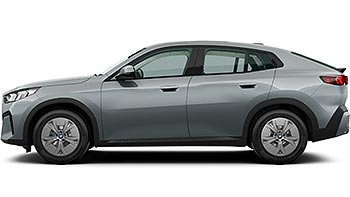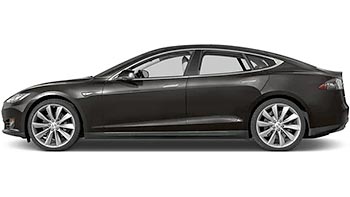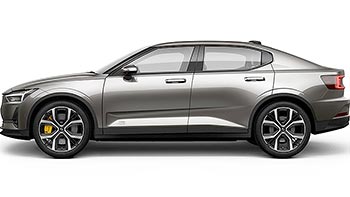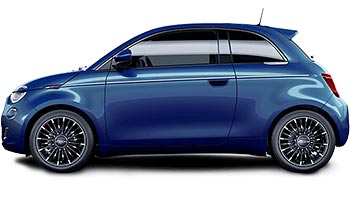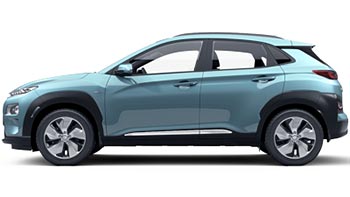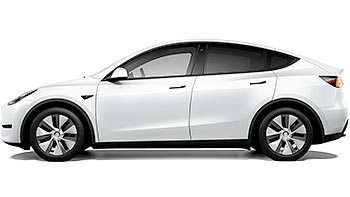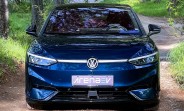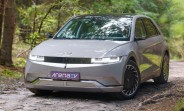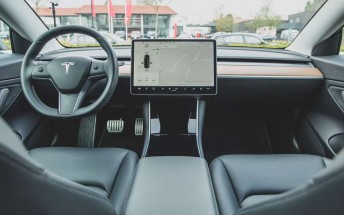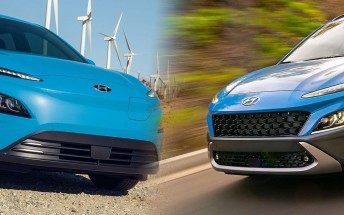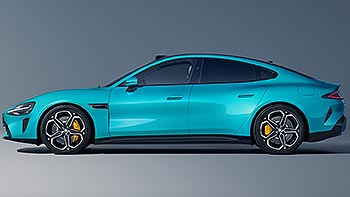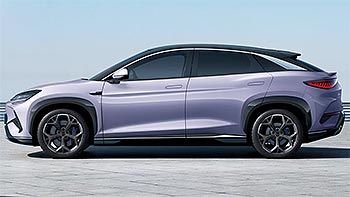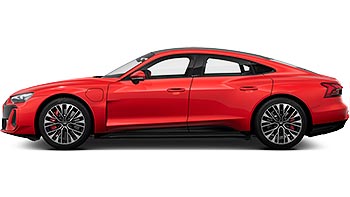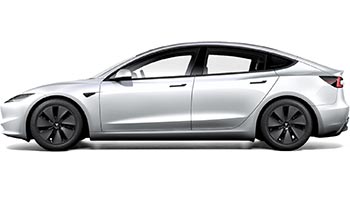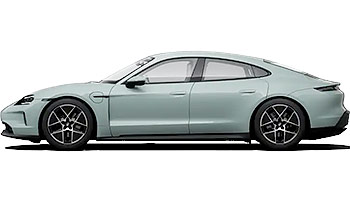Volkswagen ID.7 Pro review
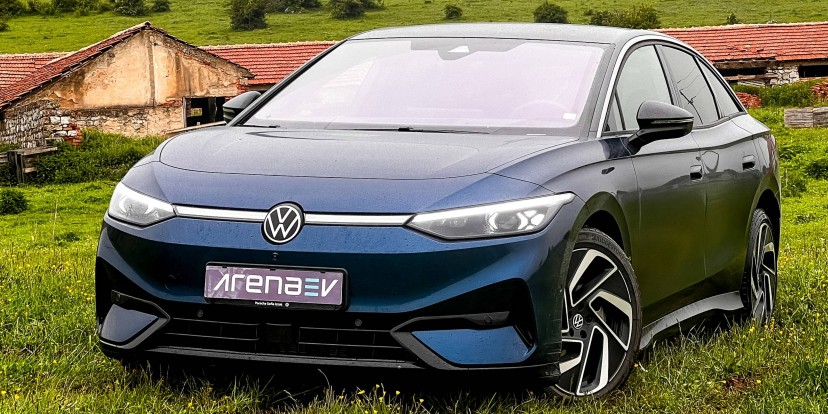
Volkswagen has a long and successful history of making reliable and practical sedans that serve families and businesses all around the world. Now the guys at Wolfsburg delivered their first fully electric sedan that aims to carry the legendary Volkswagen Passat's legacy into the new era.

Table of Contents:
- Exterior
- Interior
- Storage & practicalities
- Driving experience
- Tech features
- Ride comfort
- Cabin noise
- Acceleration and braking
- Consumption
- Charging speed
- Competition
- Verdict
With the introduction of the ID.7, Volkswagen looks to convince its millions of happy customers to make the switch to an electric vehicle. This task is challenging as the ICE Passat has been the indusrty benchmark for decades now and the ID.7 has some big shoes to fill.
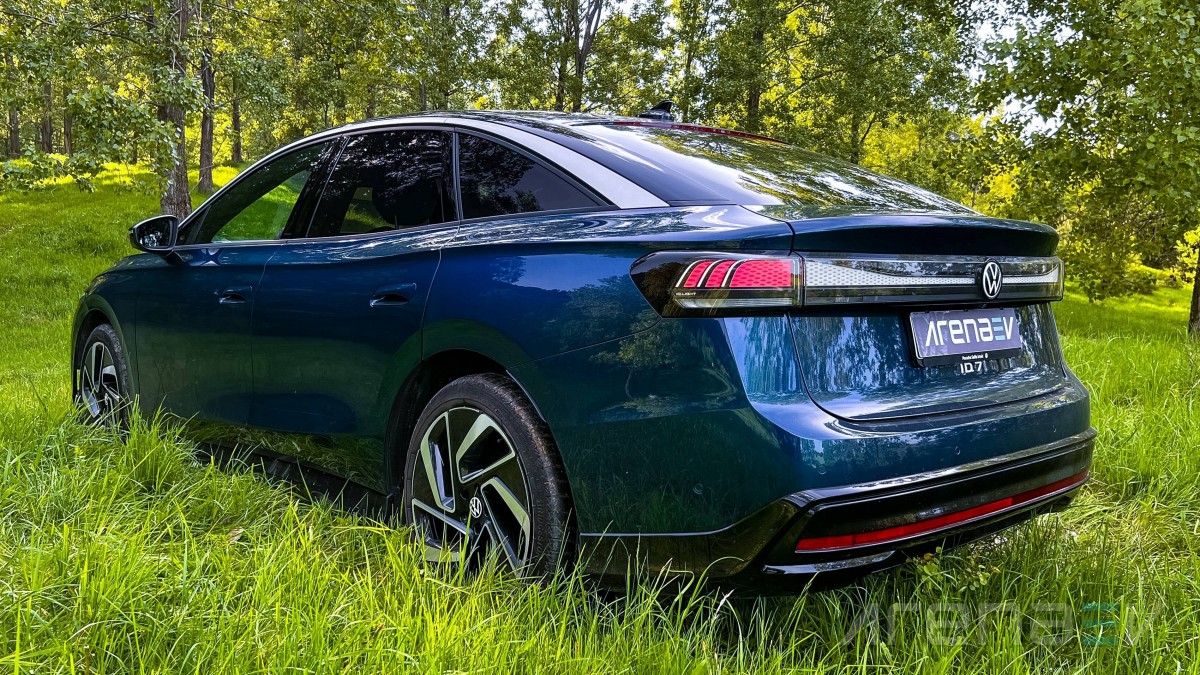
The model we are reviewing today is the Volkswagen ID.7 Pro, which is currently the only variant available to purchase. It delivers 286 hp and 402 lb-ft to the rear wheels. The battery pack has a usable capacity of 77 kWh, but a Pro S version with a bigger 86 kWh pack is expected to debut later this year. Thrill seekers are also looking forward to a ID.7 GTX, which will have all-wheel drive and 335 hp output.
- Dimensions: 195.3 inches x 73.3 inches x 60.5 inches, 117 inches wheelbase.
- Drivetrain tested: Pro - RWD 210 kW (286 hp), 402 lb-ft, 82 kWh total battery capacity, 77 kWh usable battery capacity
- Other drivetrains: GTX - AWD 246 kW (335 hp), 91 kWh total battery capacity, 86 kWh usable battery capacity
- Charging: 175 kW CCS; 10-80% in 28 min.
- Range: 386 miles WLTP (618 km EPA)
- Weight: 4,788 lb unladen, 5,798 lb gross
- Other features: Multilevel ambient lighting, games, OTA updates.
Exterior
The outside of the Volkswagen ID.7 Pro is typically conservative for the brand and can even be described as bland. The ID.7 certainly isn't ugly, but it doesn't really invoke strong emotions with its understated exterior. Still, function over form is how VW built its success over the years and here that means excellent aerodynamics and maximizing cargo space and passengers' room.
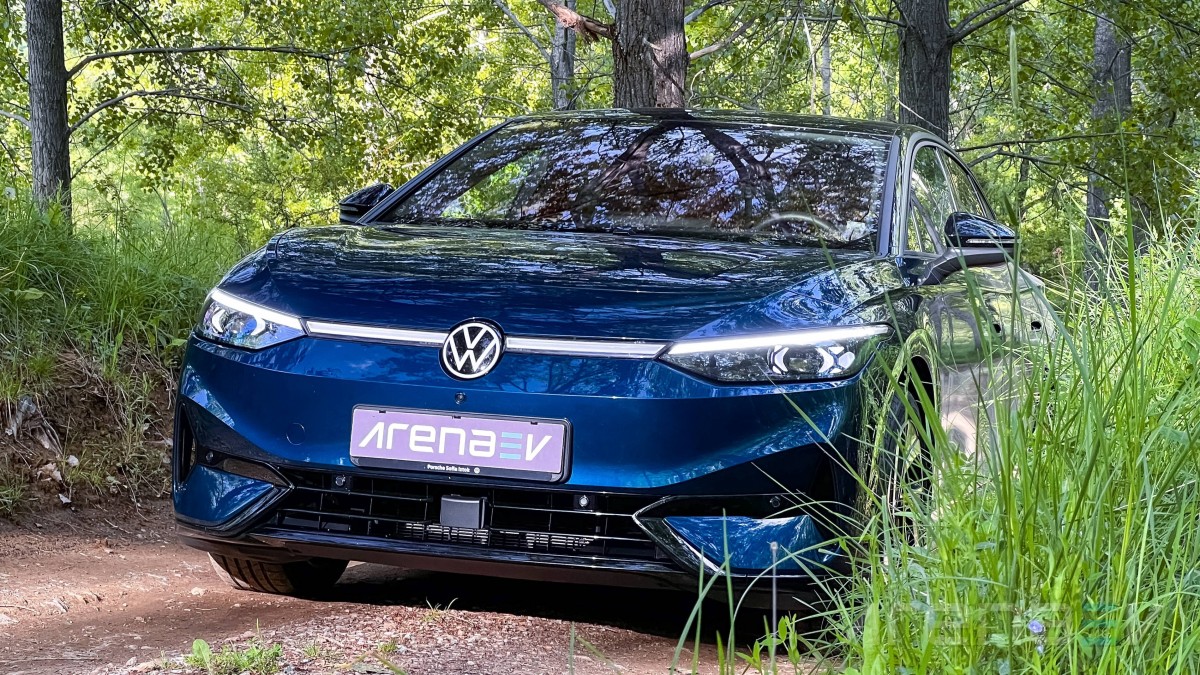
The front of the ID.7 is highly reminiscent of a number of other Volkswagen models like the Golf, ID.3 and ID.4. Since the ID.7 is electric it needs no big center grille and makes do with a small one on the lower part of the bumper, whereas all other surfaces follow the body lines to make the front as slippery as possible and reduce drag.
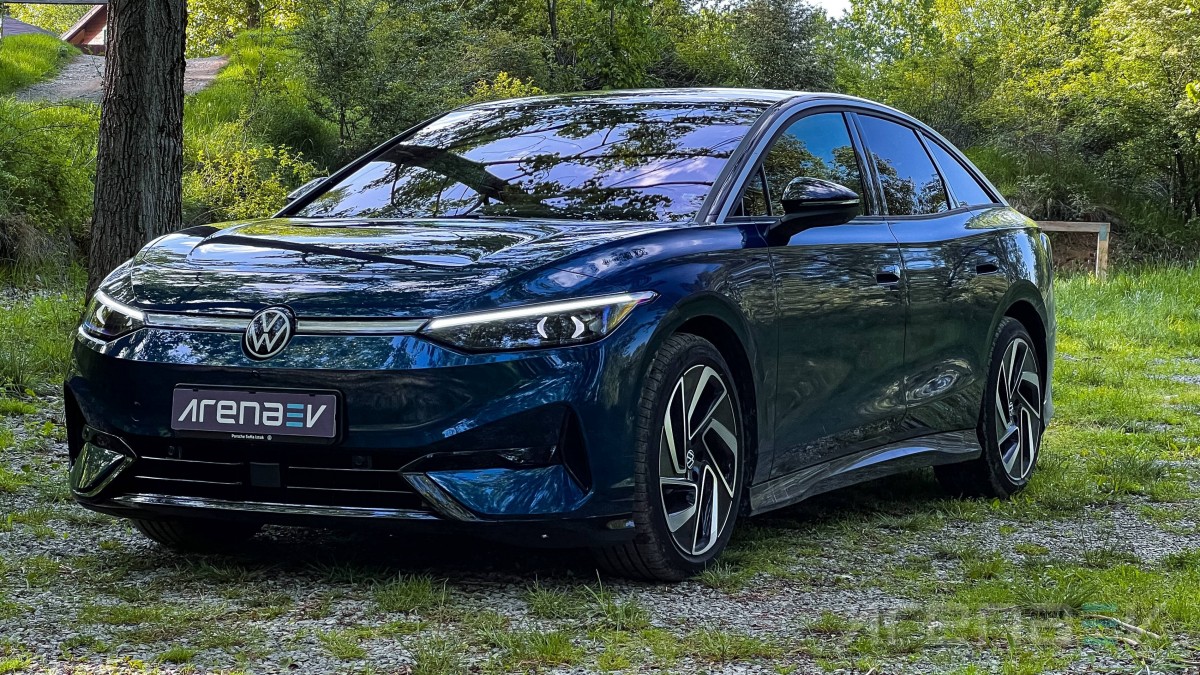
A big VW logo sits prominently in the center, surrounded by the extensions of the headlights that serve as a LED bar at night. They look more as an afterthought, though, as they don't naturally continue from the headlights and end abruptly near the logo. However, the matrix headlights work great and nicely illuminate the road ahead without blinding oncoming traffic.
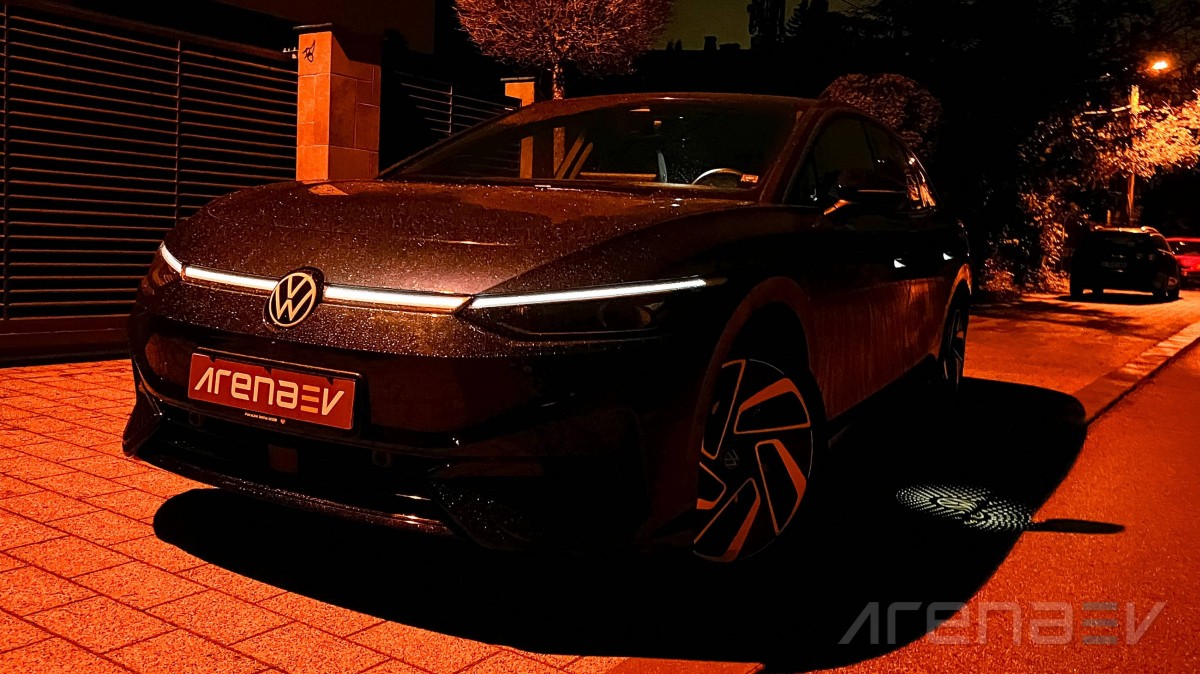
The ID.7 has a low hood, rising into a tall roofline, which slowly fades into the trunk. The ID.7 is substantially higher than the ICE Passat, which results by raised ground clearance and a pursuit of expanding headroom, resulting in a more SUV-like seating position and driving experience.
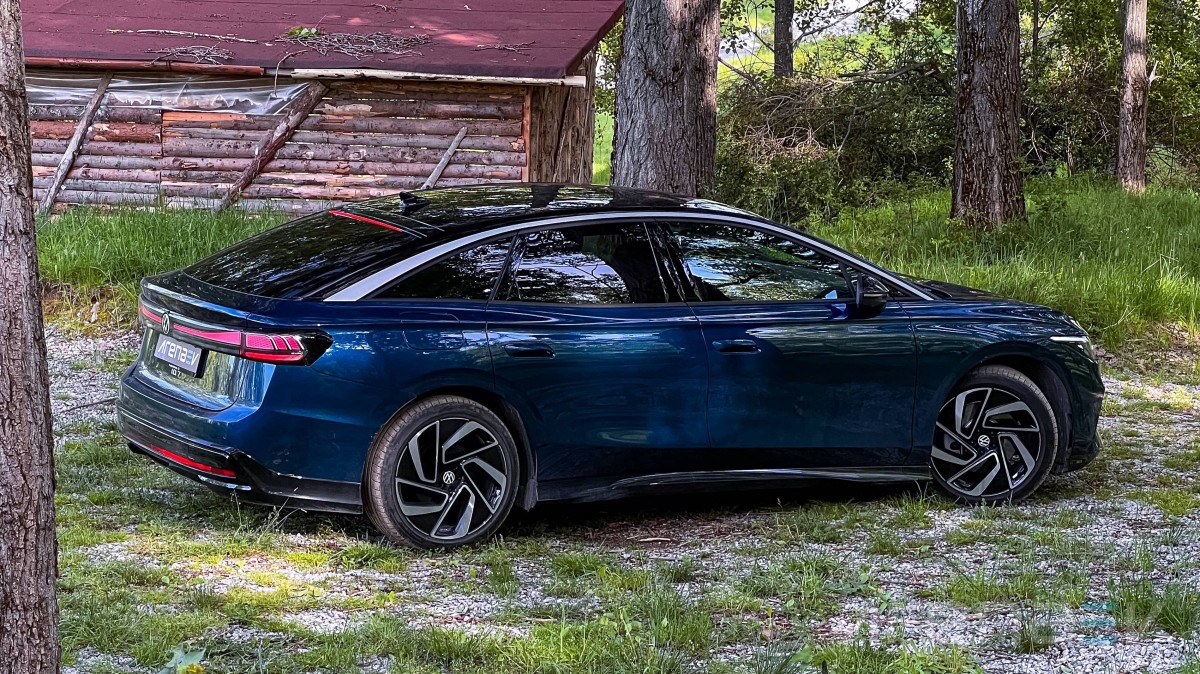
The door handles are optimized for better airflow, yet don't pop out the doors like many other manufacturers do, enabling simple and straightforward usage, compared to the awkward and unintuitive solutions of some flush solutions by other makers. The material selection could be better though as the ID.7 handles fold and squeak when opening the door with more than minimal force.
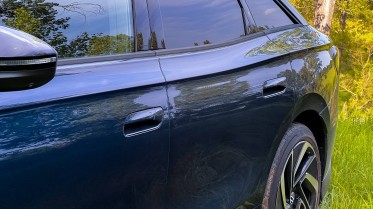
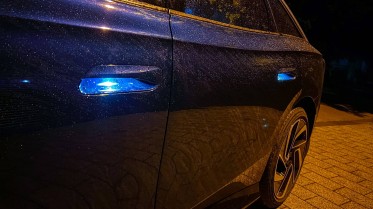
The door handles look cool, but feel poorly made.
The ID.7 Pro sits on some big 20-inch tires, which are narrower up front (235/45 front; 255/40 back). The entire rear track is also wider, resulting in better handling and stability at higher speeds. You can also opt for 19-inch wheels, which will further improve efficiency at the expense of worsening the looks of your ID.7.
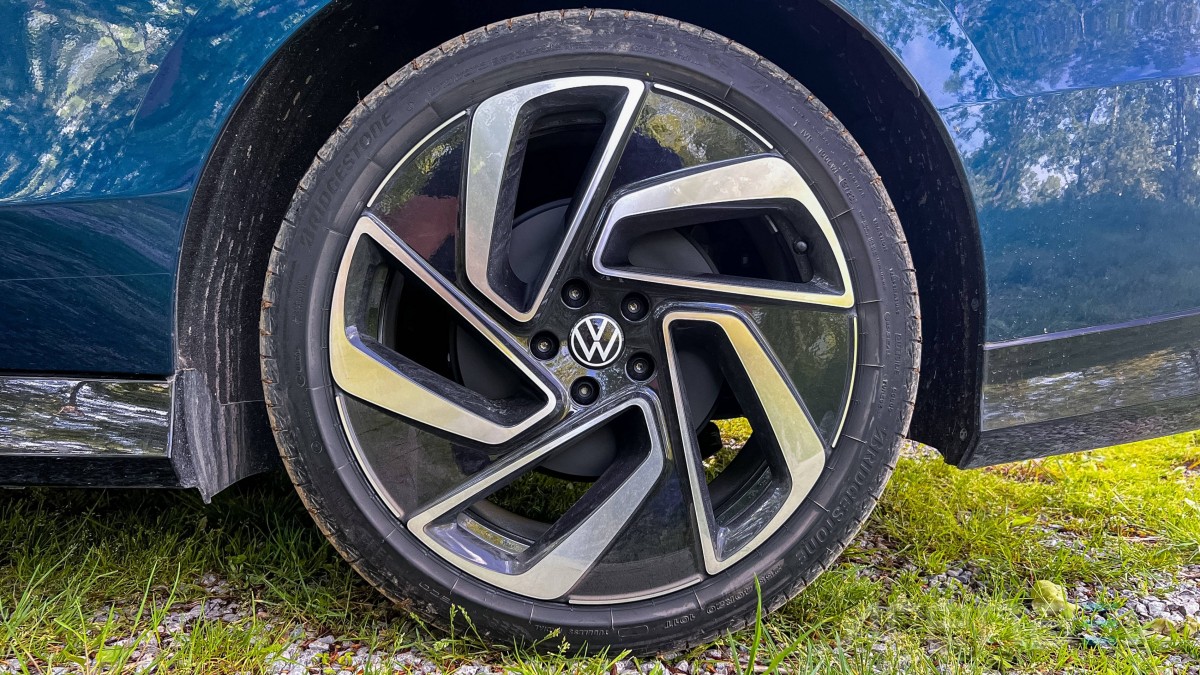
The rear end of the ID.7 Pro makes it seem like the car is narrower than it actually is, thanks to the sloping black roofline and chromed trim that surrounds it. Combined with the high ground clearance and the low-mounted rear LED bar, the entire back looks disproportionate and like it was first designed for another car and then stretched to fit in this one. The ID.7 is about 10 cm narrower than similar models like the Tesla Model S or the Mercedes EQE, but impressively neither of those feel notably more spacious on the inside than the Volkswagen.
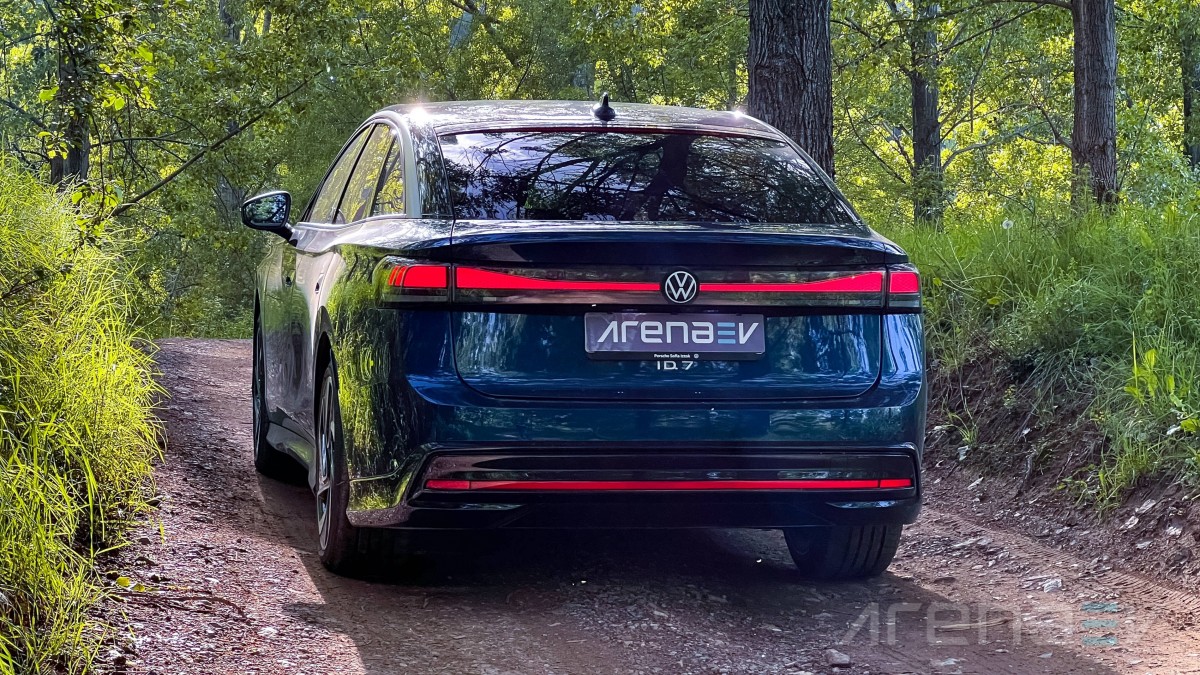
The trunk of the ID.7 actually opens with the rear window, making the car technically a hatchback. This is due to the sloping roof and helps when loading bigger items.
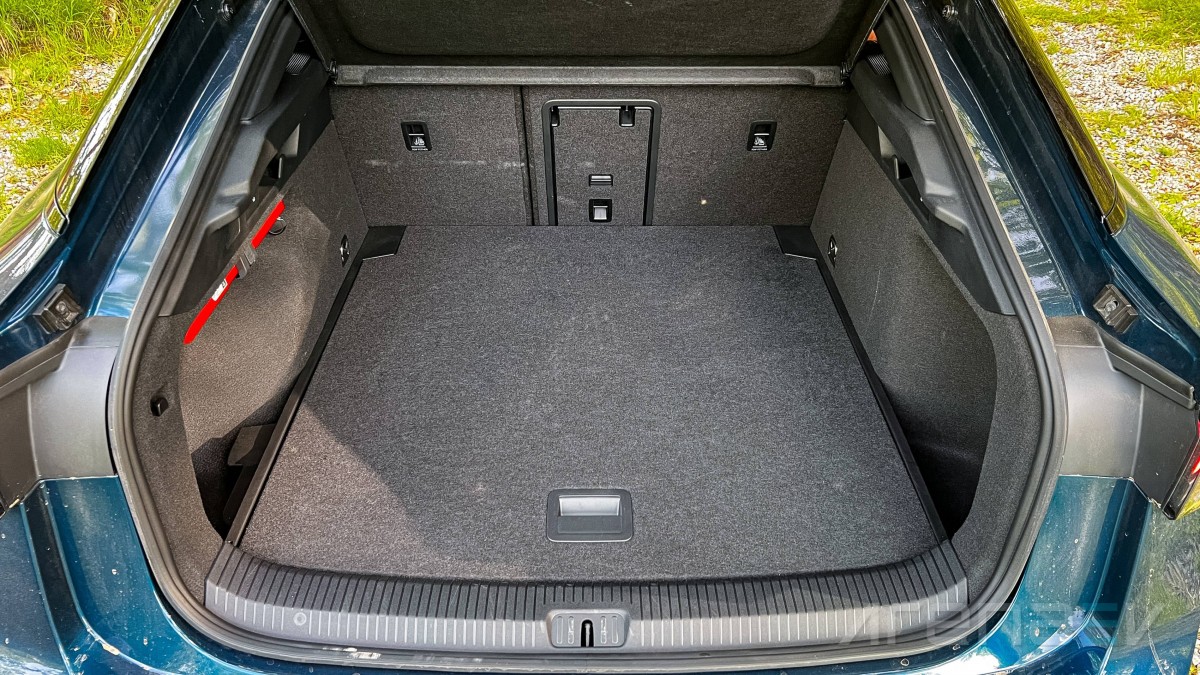
The rear lights are connected like the headlights up front, but here they seem well thought out and fit with the rest of the design features. Their flowing lines and curvy LED signatures deliver a distinctive look at night and the little hexagon pattern is very cool up close.
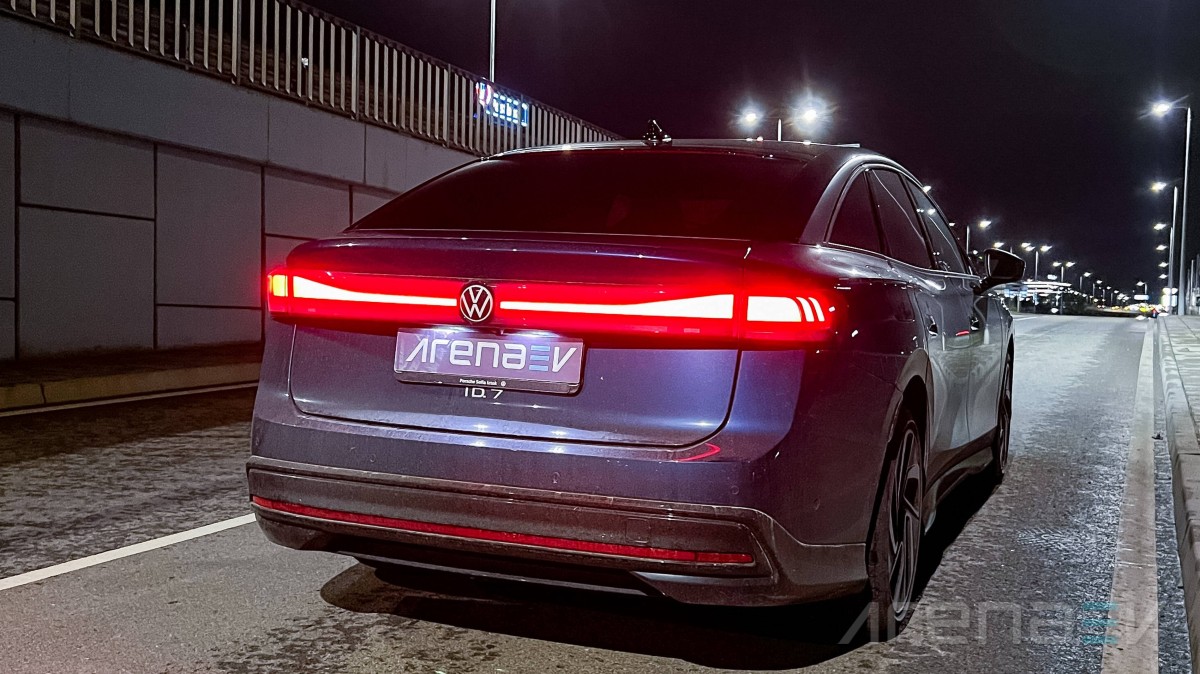
Interior
Inside, the ID.7 is a typical Volkswagen - nothing excessive, but an overall pleasant atmosphere to spend time in. It verges on being boring, but it offers all you need with above average build and material quality. And in the family sedan segment this is arguably the approach tha makes the most sense.
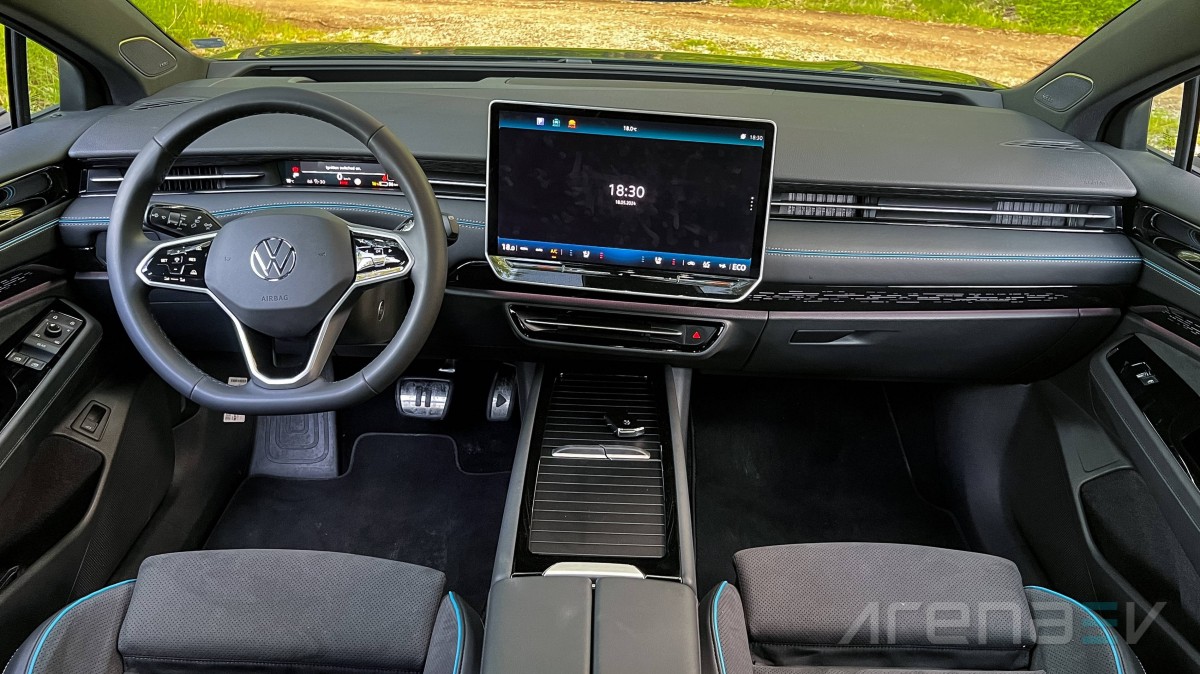
When you first step inside the driver's seat, you notice the play and pause symbols on the pedals for the accelerator and brake.
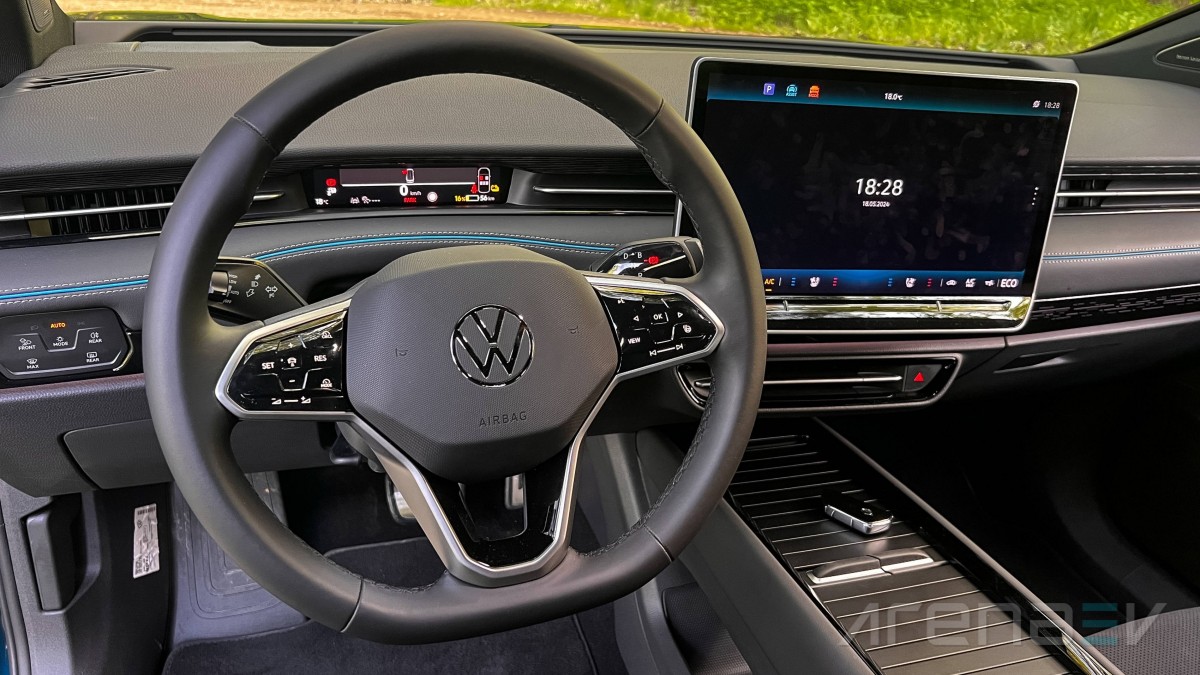
A large, but thin steering wheel welcomes you by automatically lifting itself. On it are the controls for the audio, cruise control and settings. The last ones are mostly redundant as you can only access a few options from there and have to go to the multimedia screen for the full setup. The buttons themselves are touch-sensitive with haptic feedback and finished in piano black. This means they are somewhat hard to operate, but very easy to smudge - this has been a major point of complaints for Volkswagen models in recent years and is sadly still the case here.
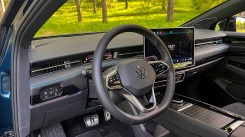
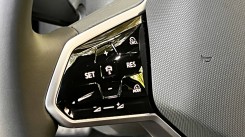
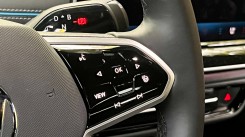
The steering wheel has haptic feedback buttons on the steering wheel.
The stalks on the steering column are nicely weighted and feel good to the touch. Volkswagen is following the footsteps of Hyundai by making the gear lever have the D and R position switched up compared to most other automatic vehicles, which takes some getting used to.
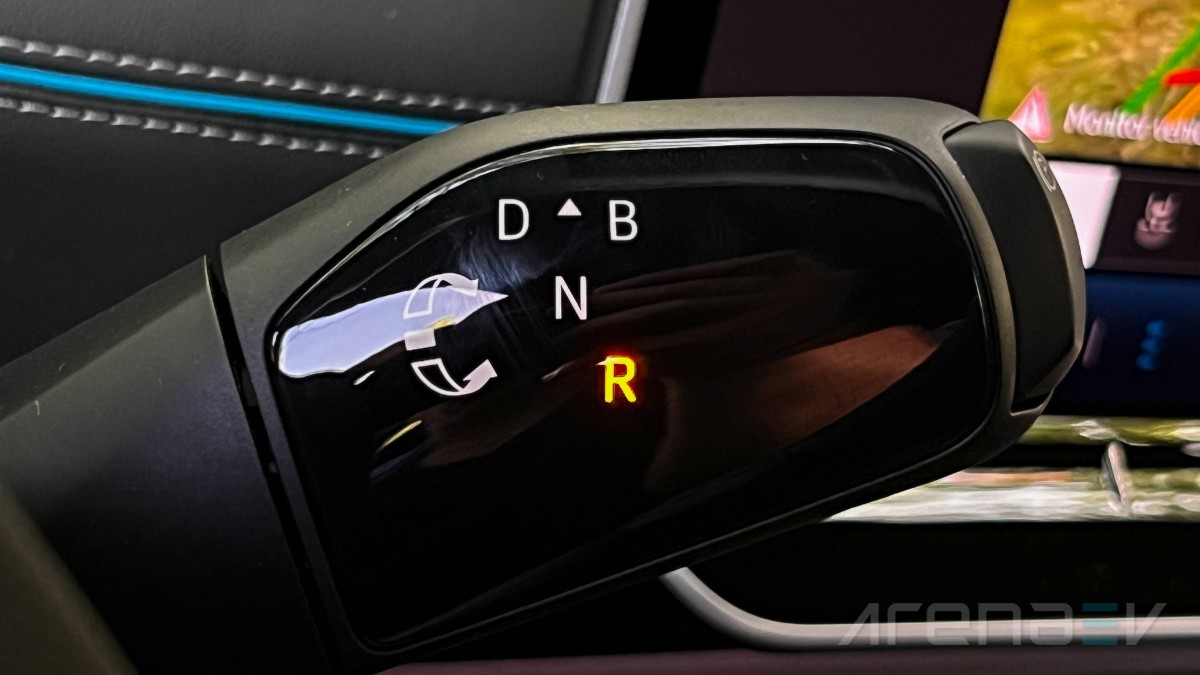
On the right side of the steering column there is a start/stop button, which is actually redundant. When you step on the brake pedal and turn the gear selector in whichever position you want, the ID.7 starts and goes, whereas the moment you press P or open the door, the vehicle turns off and you can safely exit and lock, without needing to ever press the start/stop button.
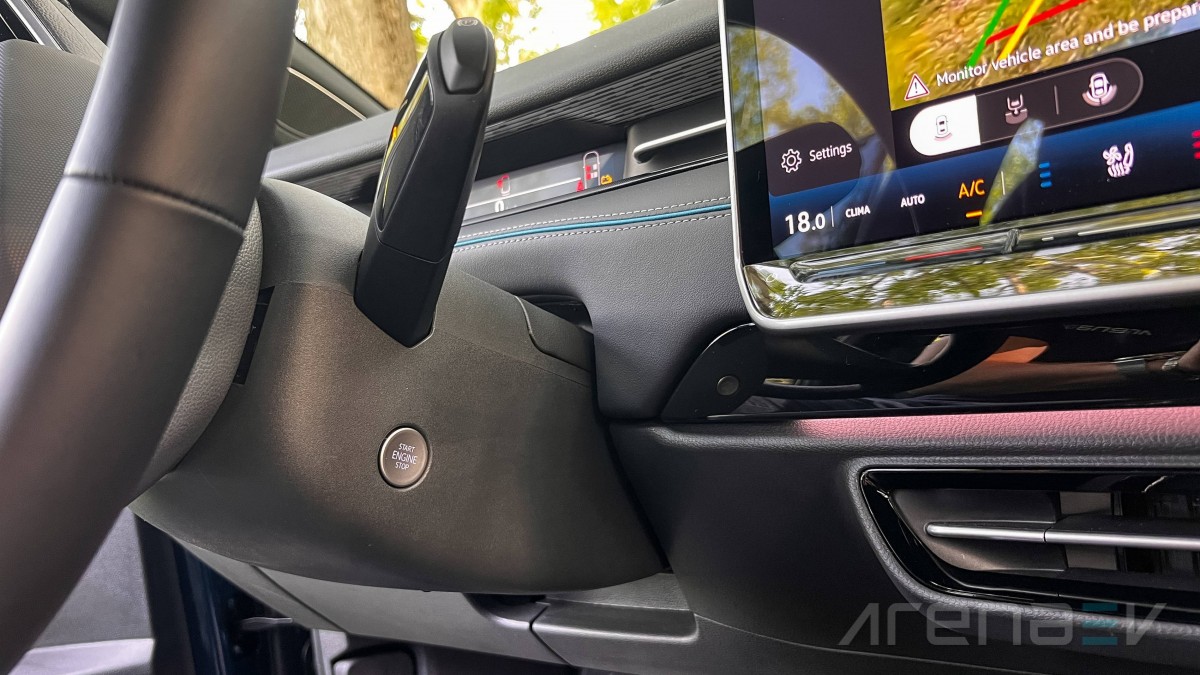
Behind the steering wheel is the gauge cluster display, which is similar to what other ID models offer, but it looks much classier here. The readouts on it are small and not descriptive enough. There are no cool graphics either, giving off a cheap and basic look.

To the left of the steering wheel is a set of capacitive touch buttons that control the lights and the defrosters - definitely a weird combination. What’s more interesting is the way they operate, where you have to press them with enough precision and not much power, otherwise they’ll not accept the command or just select a neighboring one instead. It is amongst the worst and most overcomplicated modules in the industry, adding unpredicatability to operating basic features.
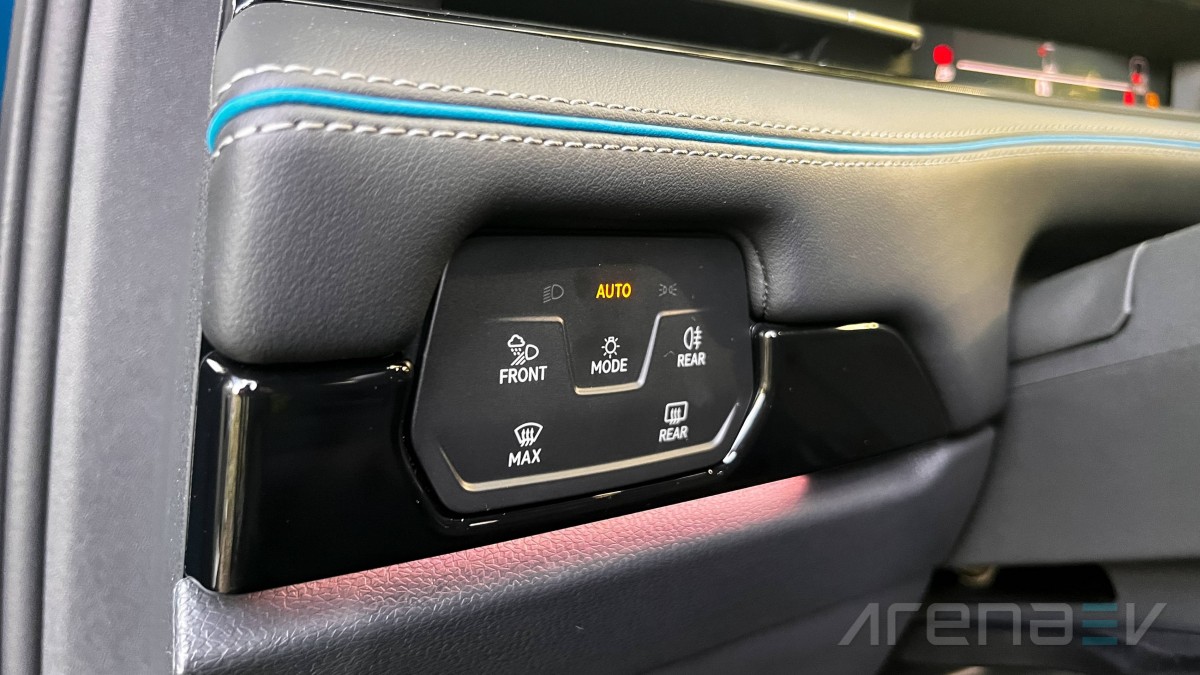
In the center of the ID.7 sits the massive 15” infotainment display, which opearates most vehicle functions. The touchscreen unit is a massive upgrade compared to other ID models we’ve previously tested like the ID.4 or ID.Buzz. It works well with quick response times and much improved UI. The bigger size makes the whole experience more pleasant, but it should be noted that the unit squeaks a lot due to the cheap plastics surrounding the screen.

An extension of the screen is a row of capacitive touch buttons that control the temperature and audio volume. When first introduced on VW models thosehad no backlight, making themhard to use at night. Now, at least they light up, but are still less convenient than a knob or a regular button.
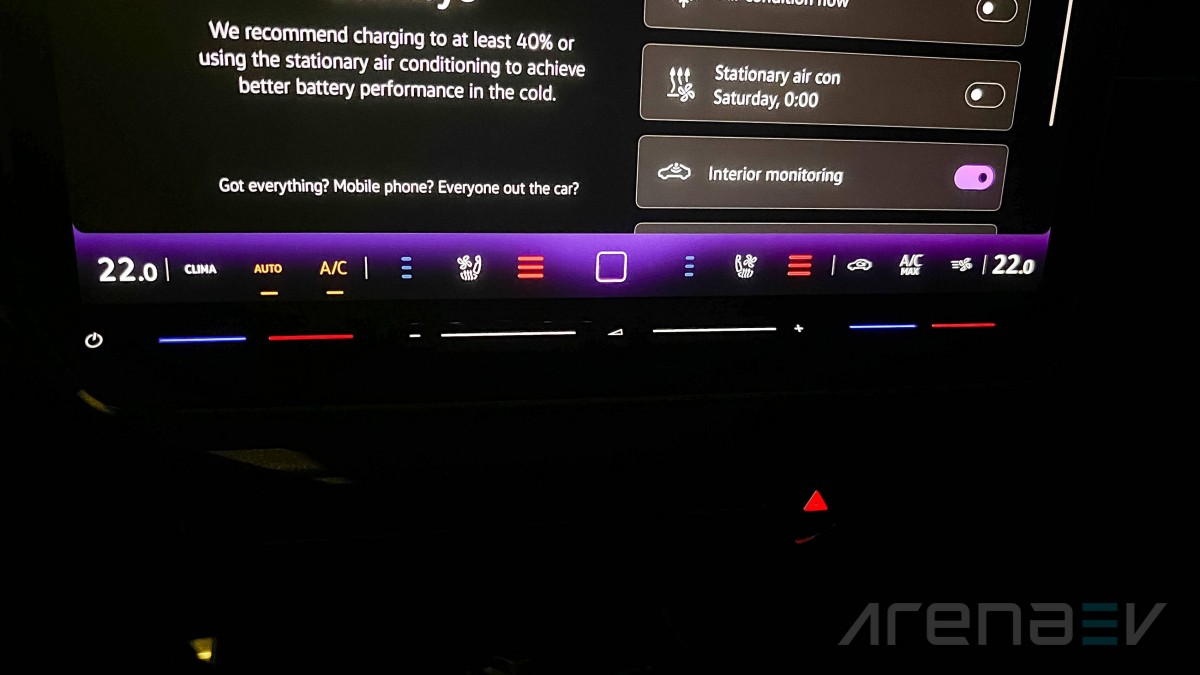
The only real button in the entire front of the ID.7 is the hazard lights one - as the latest safety regulations mandate a non-touch control for those. It is mounted next to the middle climate vent and sits awkwardly off-center, suggesting it was not part of the original design and Volkswagen only moved it as it needed to comply with the new rules.
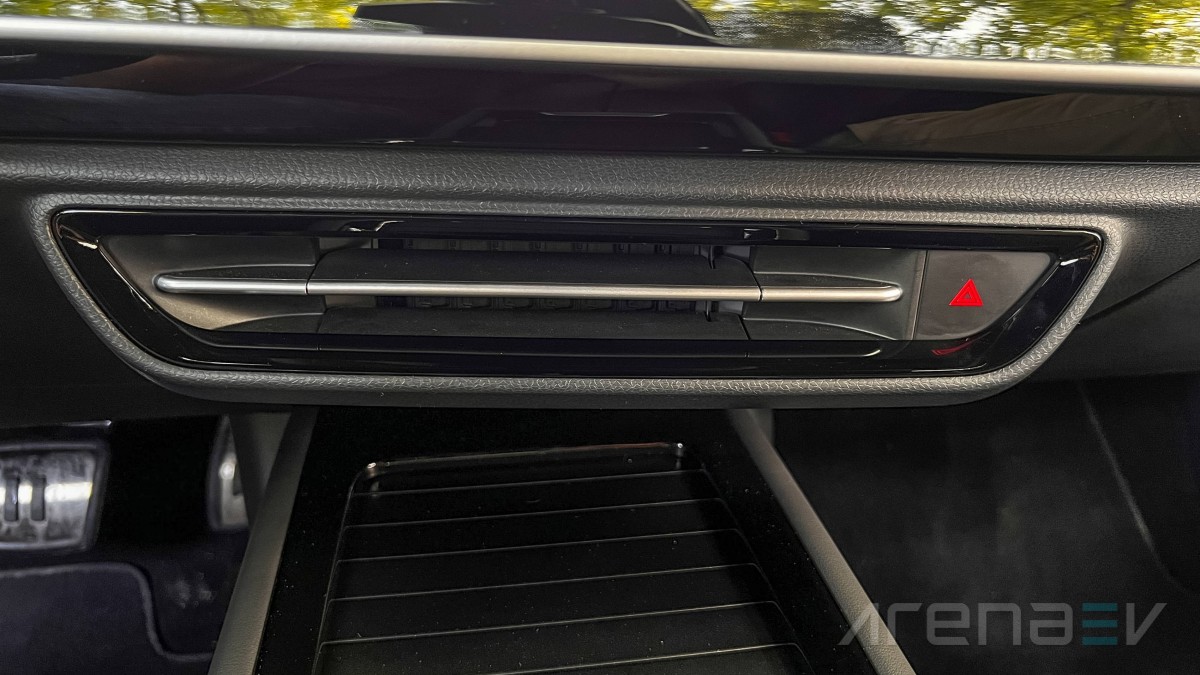
The center console has a giant space that is covered by two plastic lids that feel flimsy and cheap, but beneath them you can safely store a lot of items. There are two cup holders and two USB-C charge ports, as well as a wireless charging pad. Below the console you can even fit a medium-sized handbag, the wide opening boosting convenience.
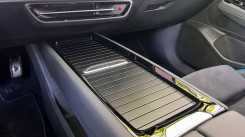
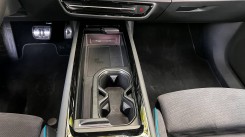
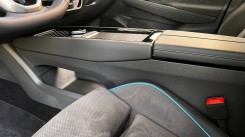
The center console hides a lot of useful storage spaces.
Underneath the center armrest lies a deep storage pocket, which can easily store big water bottles. It also comes with a separator for smaller items that you can move around or decide not to use at all.
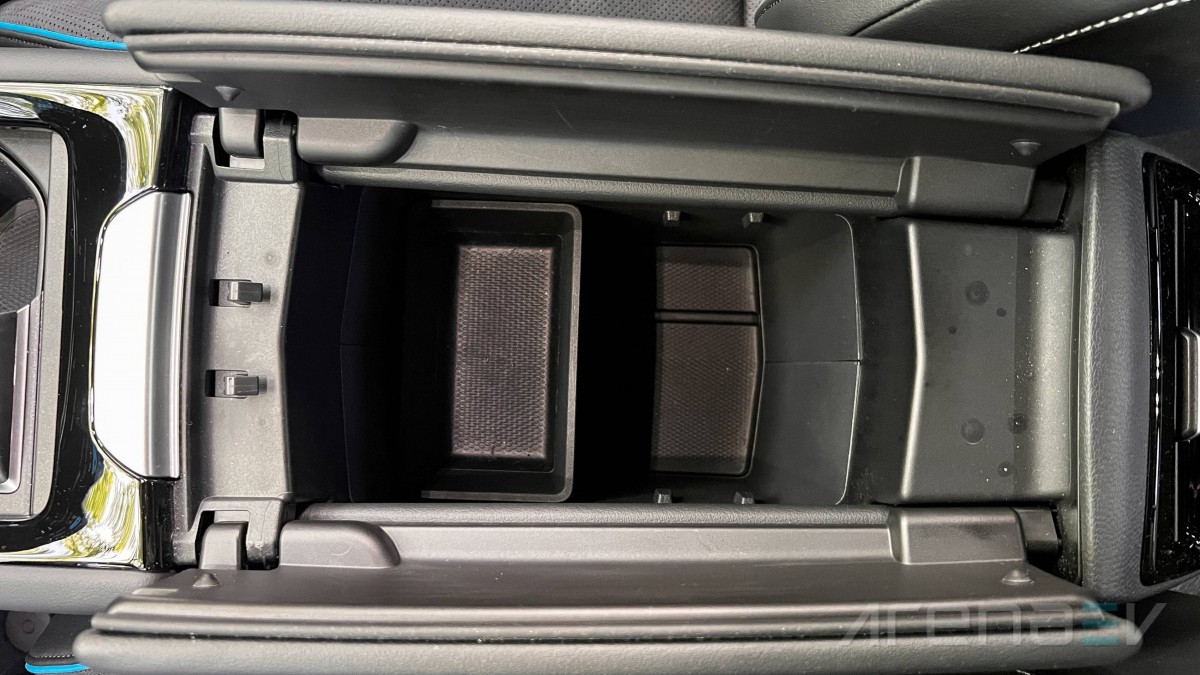
In front of the front row passenger and on the door panels is the most interesting detail of the whole interior - the ambient lighting. The design pattern is futuristic and you get to pick between a huge number of lighting configurations. You can select what type of color each part of the interior to be lit in, creating unique patterns and the multiple available colors ensure endless combinations. Obviously there are also presets if you don't want to bother with the granular settings.
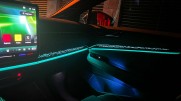
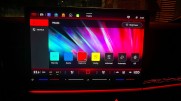
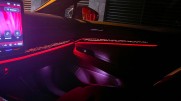
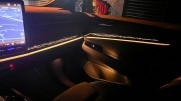
There are multiple ways to personalize the ambient lighting in the ID.7.
The seats in the ID.7 Pro we tested were comfortable and very supportive. Even though they are finished in alcantara, they offered seat heating and ventilation. The massaging feature is a welcome boost to comfort as well. The ErgoActive seats offer a fine balance between comfort and stability, suting a number of different driving styles.
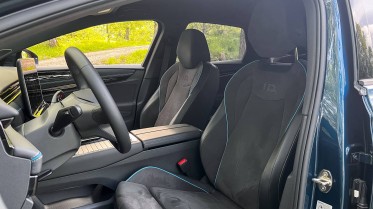
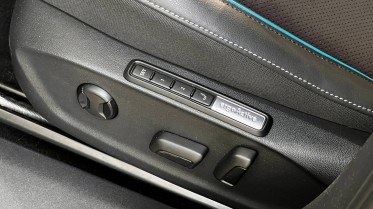
The seats masterfully combine comfort and support.
The rear seats offer generous amounts of space and even our 1.95 m (6'4") tall reviewer fits with lots of space to spare. The seat bottoms are not high enough off the floor, forcing your legs to stay in a lifted position, which is caused by the battery pack that lays on the bottom of the ID.7.
The rear passengers optionally get their own climate control, heated seats and two USB-C chargers. The doors and front seat backs offer a lot of storage pockets, which is always welcome. Everything the rear passengers touch is finished in great materials and put together well, except for the center console with its piano black finish and rattling when driving.
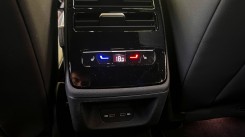
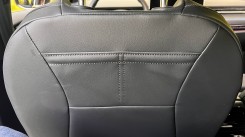
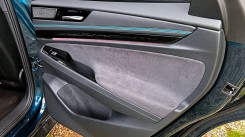
Not much luxuries for the rear passengers.
Storage & practicalities
Loading items in the ID.7 is easy as the hatchback opening allows for larger objects to enter the 18.8 ft³ trunk. The volume is higher than what most competitors offer and the double flooring allows for convenient storage of smaller items.

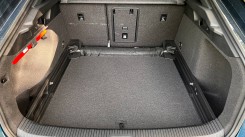
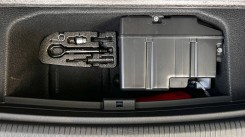
Big trunk with many smaller pockets.
With the seats folded,the maximum capacity raises to 56 ft³. Combined with the storage pockets inside, there is always enough space available for storing items big and small.
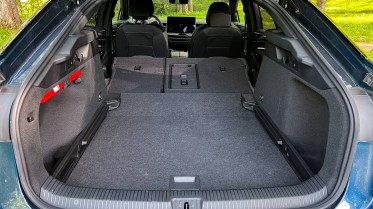
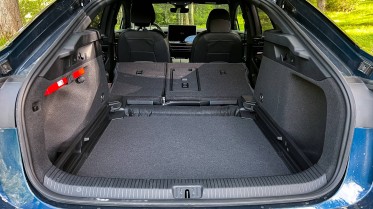
Folding the seats opens up much more storage space.
Even though the ID.7 is on an EV-specific platform, there is no frunk (front trunk). This is a missed opportunity to gain even more usability points.
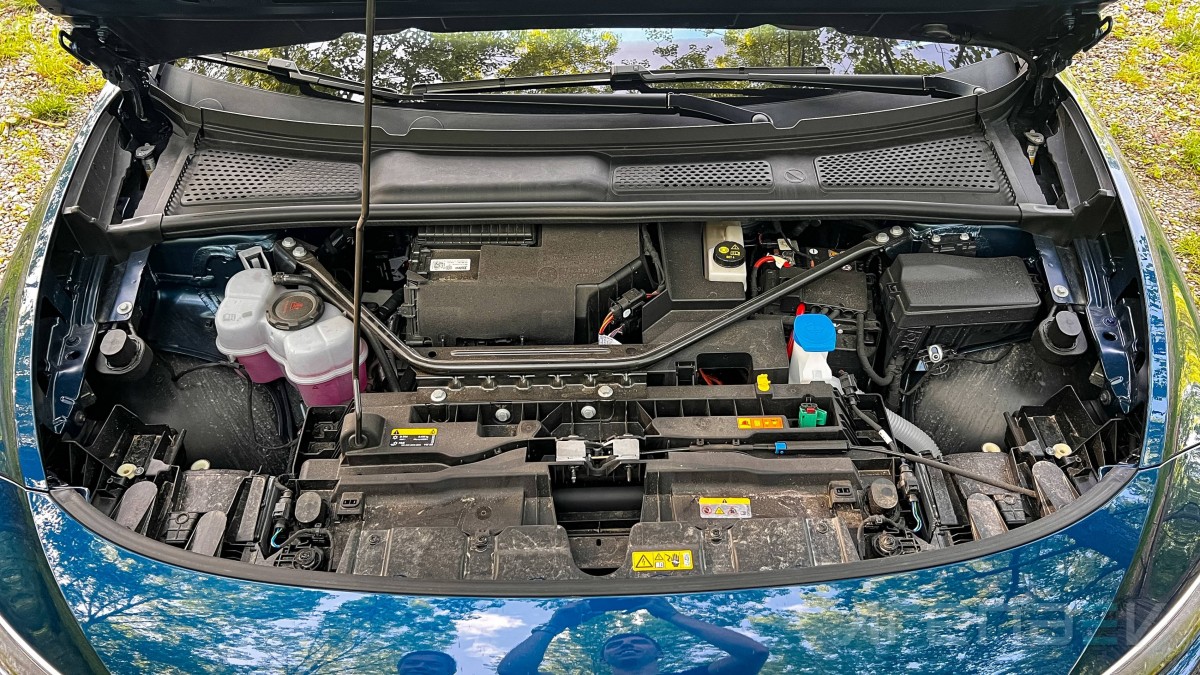
Driving experience
Piloting the Volkswagen ID.7 Pro is not the most exciting experience, but it sure is easy and relaxing. The car has a high driving position, which allows you to better see the outside world, but is not the most comortable for sporty driving. The ID.7 is predictable in corners and quite maneuverable, the RWD enabling great steering angles and exceptionally tight turning radius.
Power delivery is smooth and linear in all modes - even in Sport mode you get no significant punch when flooring the accelerator pedal. This results in a calm driving experience, ideal for daily commutes and family hauling. This formula was the foundation of the Passat's success and we are sure many will be glad to see the ID.7 retain it.
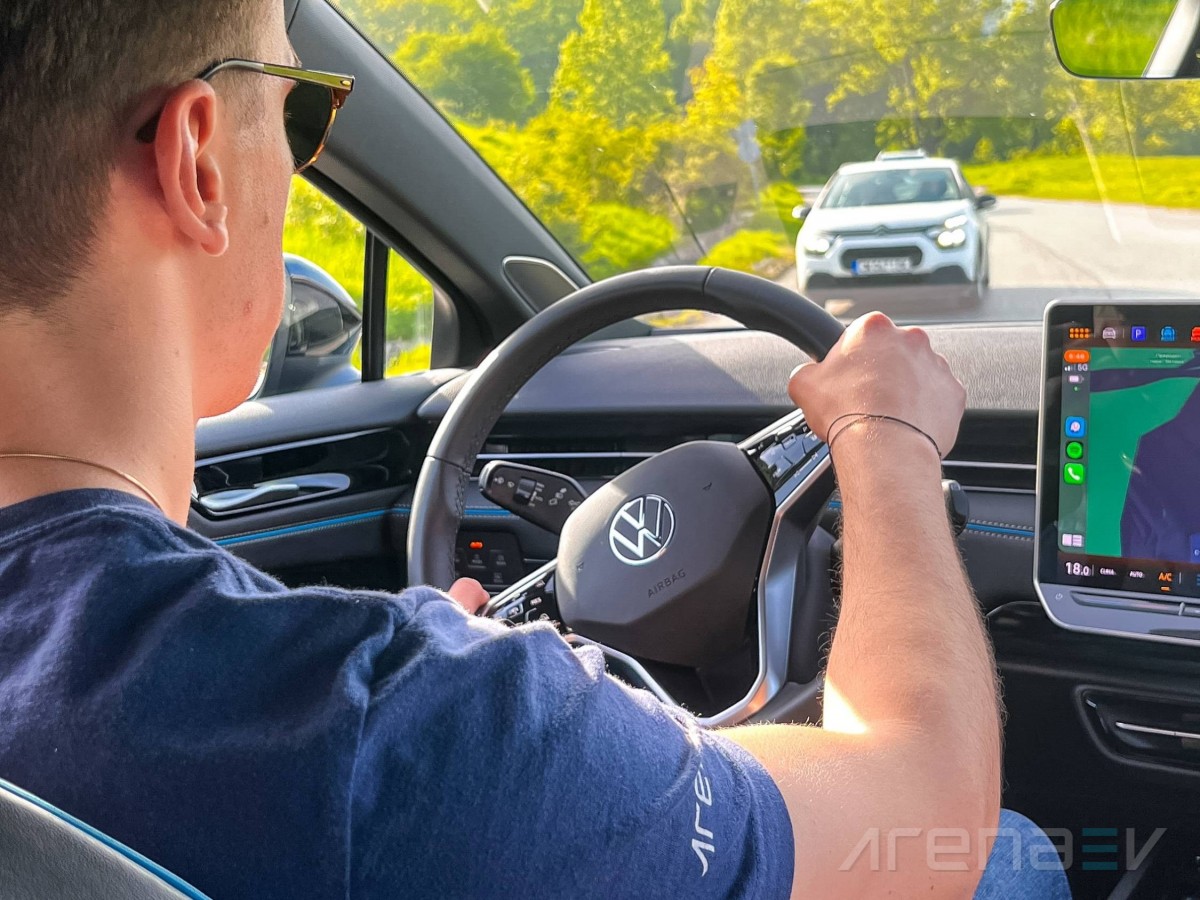
We have to praise the ID.7 Pro as it communicates with the road in a great manner. You can feel potholes and be always aware of how much traction you have, but not in an invasive way that you have wrestle with the steering wheel. The ID.7 stays well planted due to its heavy weight and low center of gravity and is surprisingly rigid for its class. It has almost no body roll, which is remarkable considering its comfortable suspension.
There are a lot of driving assistants, including L2 autonomous driving and self-parking. Sadly, some of them interfere way too much and beep loudly inside. Like the lane-keep assist, which if turned on, requires a lot of strength from the driver to go beyond the road markings. Of course, it doesn’t activate if you have your blinkers on, but in a surprising event where you need to steer in a split second this may be the difference between an accident and safety. Also, on roads with poor or no markings, the system often gets confused and is more irritating than useful.
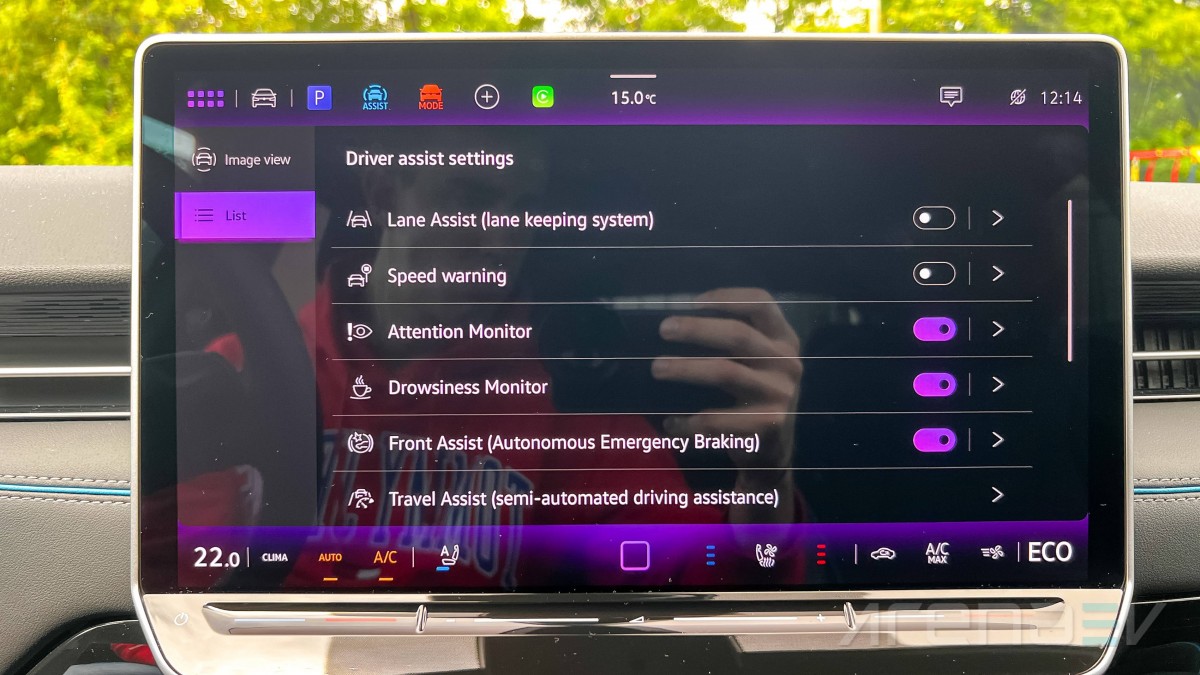
Another system that doesn't work as expected is the road sign recognition. In theory it should read the speed limit signs and force you to abide them while beeping if you go over. Sadly, it often picks up the wrong sign or misreads it and starts beeping for no reason whatsoever. This may become especially irritating on the highway if you have cruise control on, as it automatically follows the limits and adjusts the speed accordingly, resulting in a never-ending process of accelerating and braking.
The good news is these systems can be turned off with the press of a few buttons, but the bad news is the procedure has to be repeated every time you start your ID.7.
Tech features
Technology inside the ID.7 has been drastically improved compared to other recent Volkswagen models. The screen is now bigger and more responsive and is much more enjoyable to use. The ID.7 still isn't what we'd call a tech marvel, but it’s refreshing to see that Volkswagen had finally done something to brings its infotainment up to speed with the competition.
The menu screen allows you to quickly access most of the ID.7's features via big buttons, enabling you to quickly configure your car. The menus are laid out intuitively and everything is exactly where you expect it to be.
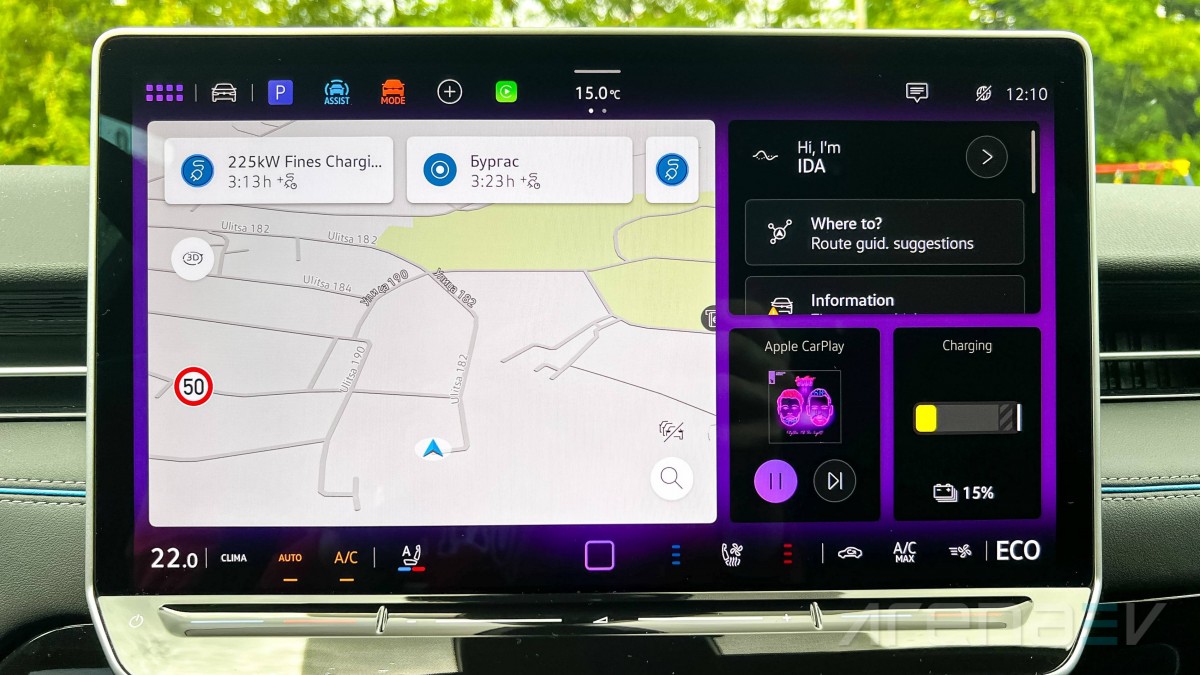
The home screen is highly customizable and can include all kinds of different information in various widgets, so you can have exactly what you need on it.
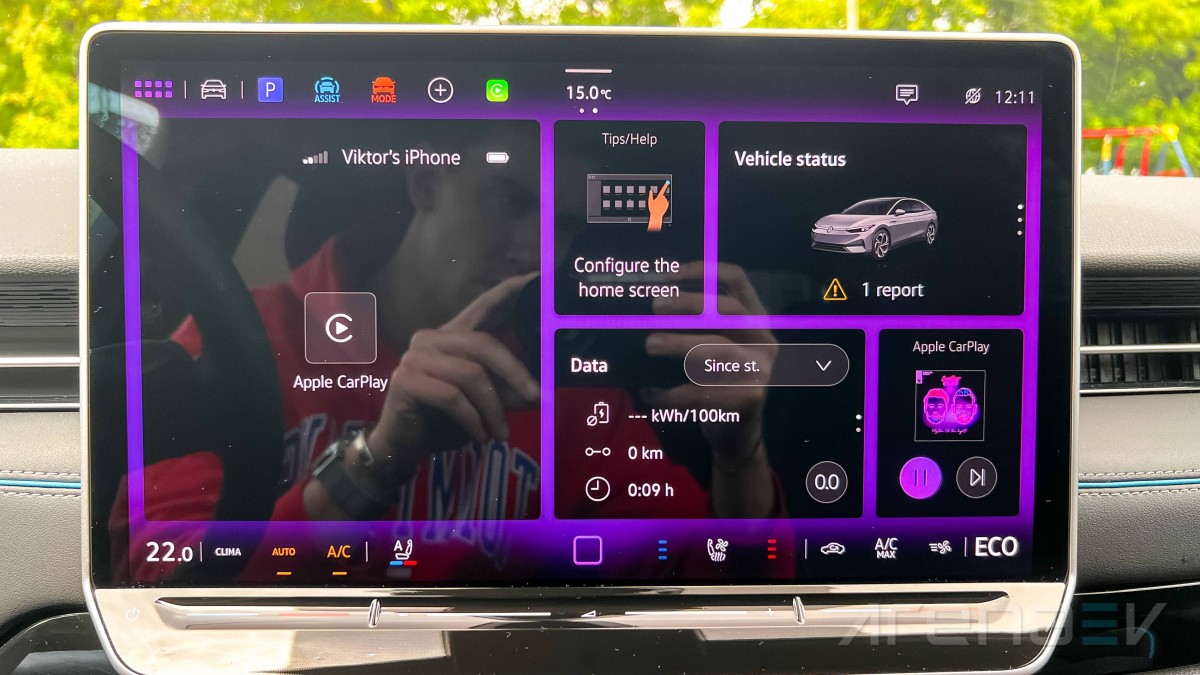
There is a settings menu with various interior and exterior features, arranged over an image of the vehicle and each setting is connected with an arrow to its corresponding part so you quickly know what's what. This sounds like a good idea until you actually have to use it and get lost in the plethora of submenus. The system also crashed a few times during testing and messed up all the settings. Thankfully, you can also opt for a more traditional list view.
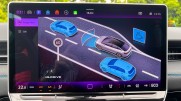
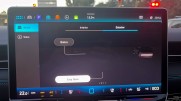
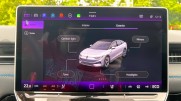

The settings are complicated to adjust and often crash.
The climate controls are not the best part of the infotainment as they require a lot of attention from the driver to adjust. The buttons that pop up on the screen are small and hard to press and the adjustment of where the vents blow air is done via the screen, instead of what virtually all cars have - a flap to manually adjust them, which is way more convenient, not to mention faster.
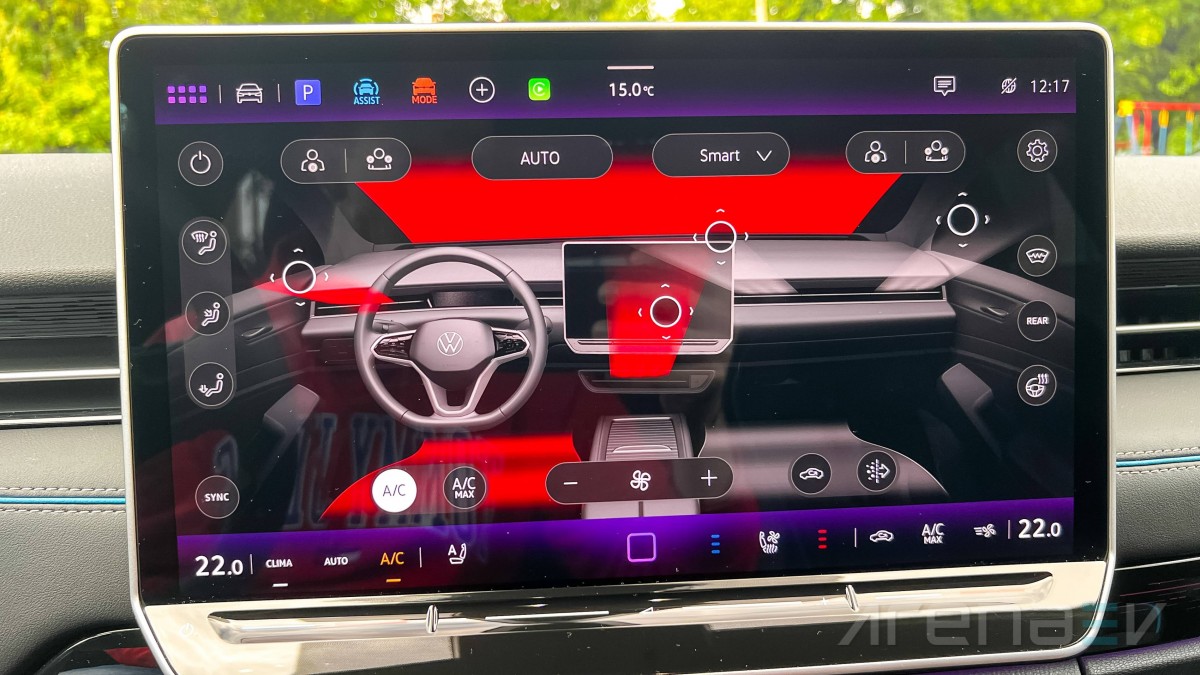
One cool shortcut for the climate controls are the smart climate presets, where you select from a list of specific heating/cooling setups and get all settings adjusted at once.
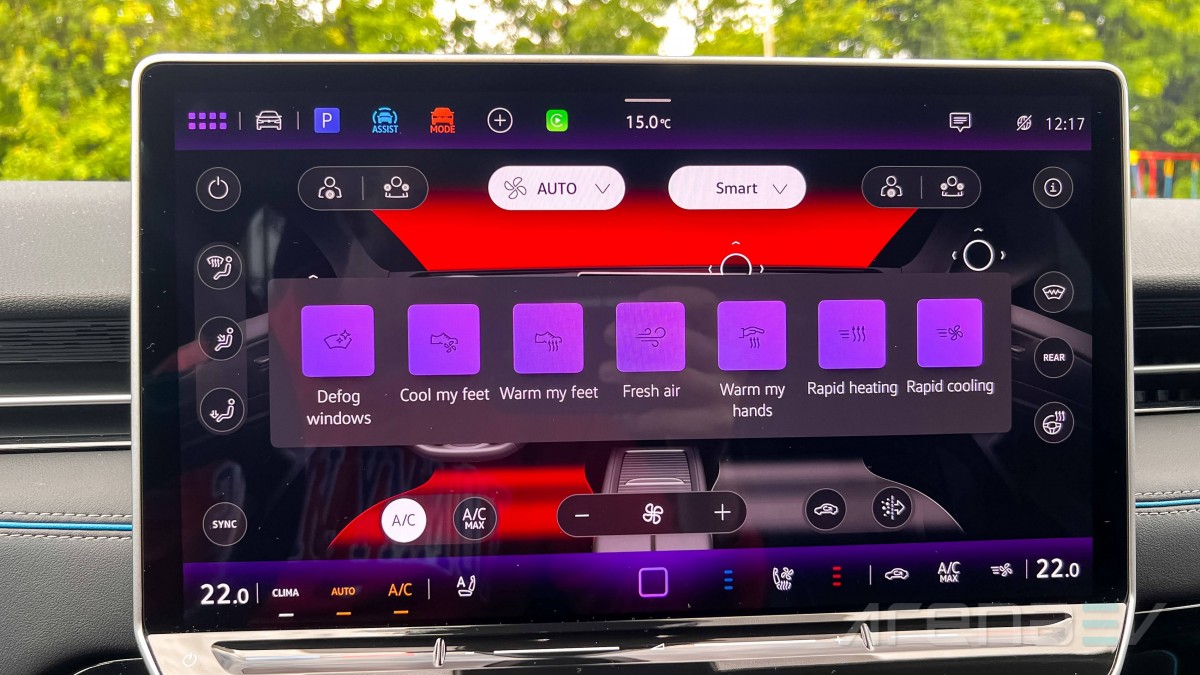
The integrated navigation system is fantastic, with up to date map data and a rich database with charging points. It is well-incorporated into the head-up display, giving you nice and deep images where you need to turn. The augmented reality feature makes it hard to miss a turn and is truly impressive to use, its focal distance setup perfectly.
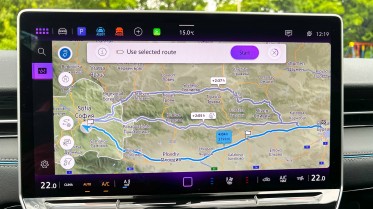
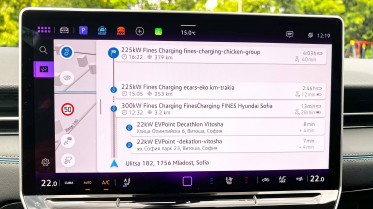
The map is smart and well-integrated.
The head-up display also projects most of the information you need when driving, making the small gauge cluster virtually redundand. In the center is your speed, to the left of it are the cruise control settings, while to the right you can choose from the navigation readout or your consumption information.
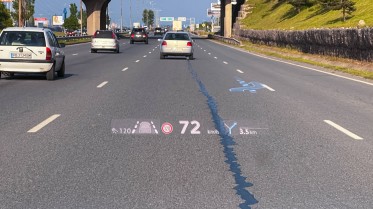
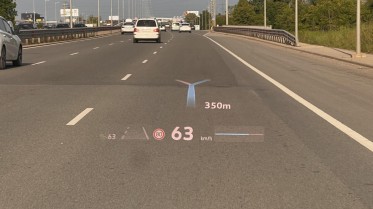
The head-up projects all the needed information while driving.
One feature that could use improvement is the camera. It comes with shockingly low image quality and is almost useless at night. During the day you get many glares and overexposed objects, which is a shame in such a modern and advanced vehicle.
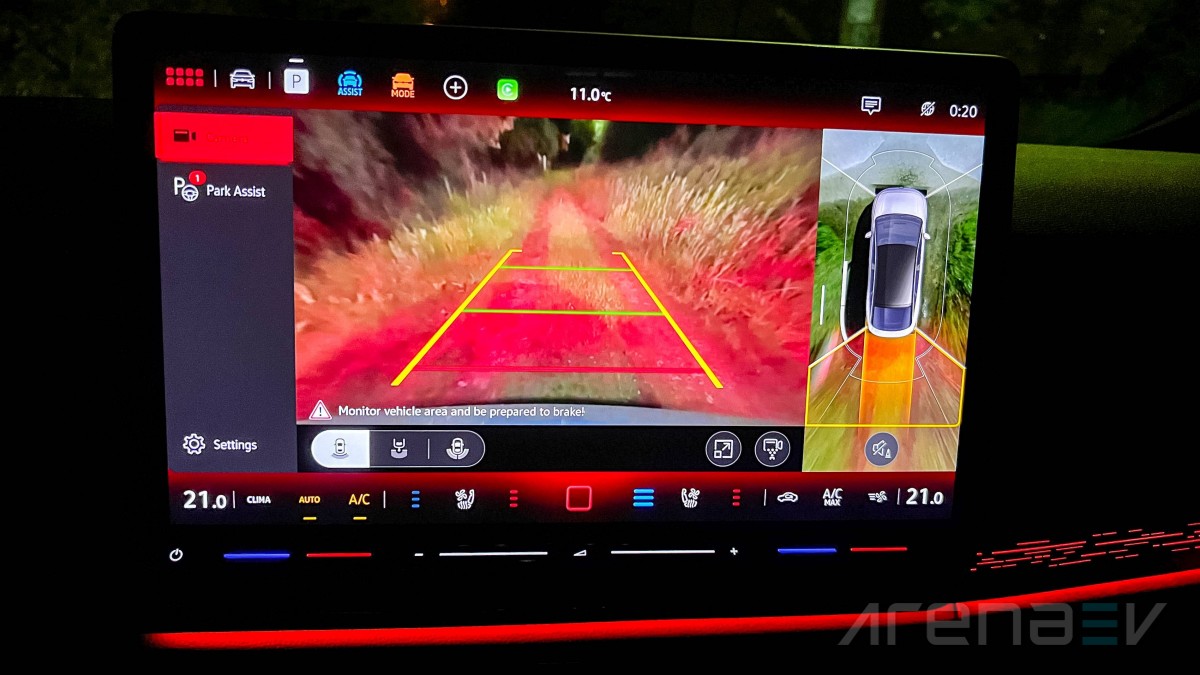
Ride comfort
The ride of the Volkswagen ID.7 Pro is balanced and smooth, exactly as you'd expect. Small bumps and uneven surfaces are barely felt, while bigger potholes and road splices are carried over to the driver and passengers, but not in a violent manner. The ID.7 is a vehicle that can take long distance journeys with ease, without tiring you a single bit.
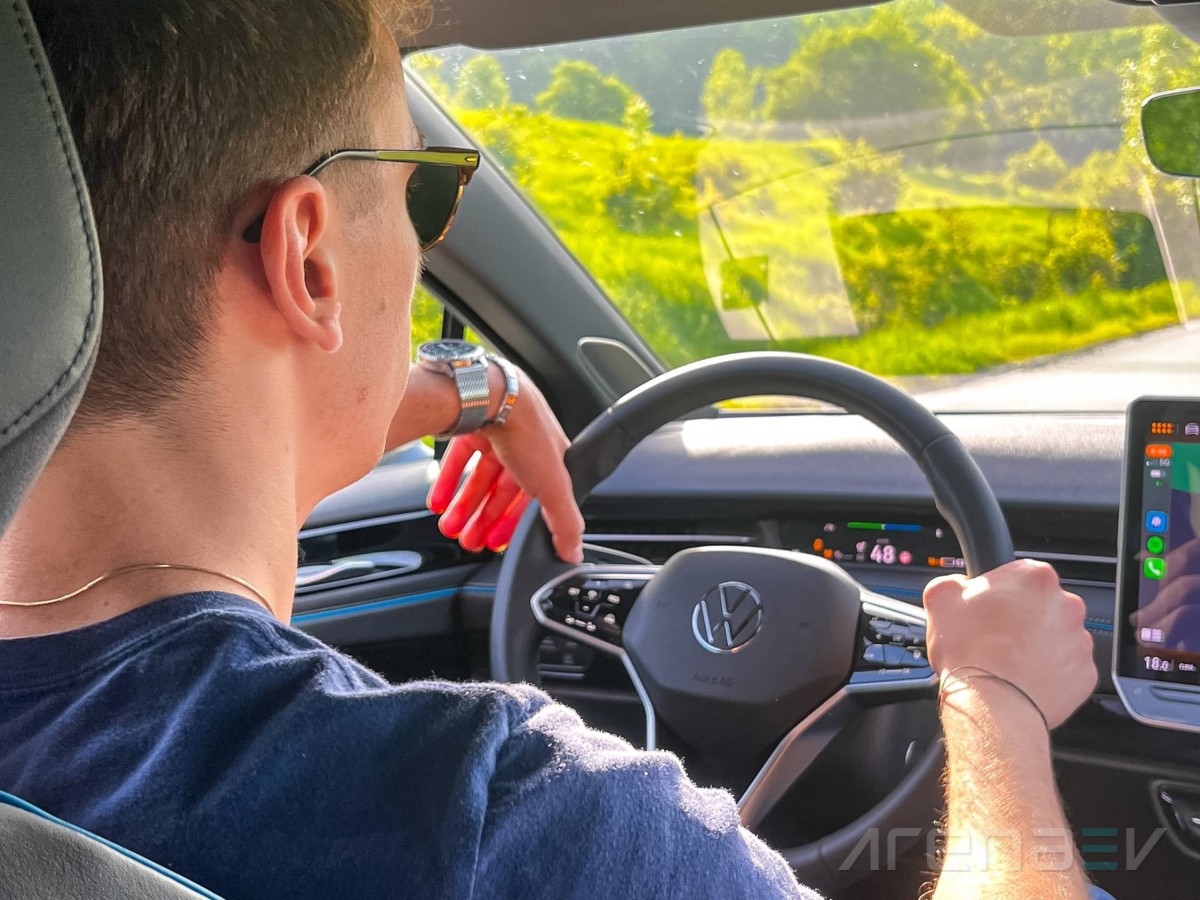
Cabin noise
The cabin of the ID.7 is nicely insulated from the ambient world. When stationary or at low speeds there are hardly ever any sounds coming from the outside. However, as speed rises wind noises start making their way inside. Especially at high speeds, there is a high pitched wind swirl that is quite noticeable inside and may prove irritating on longer journeys.
Sound level tests are carried out with a specialized sound level meter placed in the car's cupholders. The test is conducted with air conditioning and radio off and while maintaining a steady speed.
Acceleration and braking
The Pro version of the ID.7 we tested isn't particularly powerful and with only a single motor its acceleration is decent, but not spectacular. The 0 to 62 mph time we measured is 6.5 seconds, which is exactly what the manufacturer promises. It is no sports car, but most consumers that go for it will find it sufficiently fast.
Braking is a whole story, as despite its weight the ID.7 set a new record in our braking test, taking the incredible 32 m (104’11”) for a complete stop from 62 mph. This amazing result confirms what we already realized when driving the car - the brakes can decelerate the bulky Volkswagen like it weighs half of what it actually does. However, the point where the brake pedal bites the actual pads and doesn’t rely solely on engine braking is quite noticeable and not as subtle as what some rivals offer.
Acceleration and deceleration are measured with a RaceBox device inside the car. Testing is done with a single person inside the car, with air conditioning and traction control off.
Consumption
Efficiency is a key factor in the ID.7. It performs really well for its class and requires reasonable amounts of energy to operate. This means the 77 kWh battery pack can do longer trips and the upcoming bigger battery packs will only improve on that range. For more of our thoughts on the efficiency of the ID.7 Pro check out our dedicated range test article.
We measure consumption by driving at constant speeds on an identical test route during the day. Testing is conducted with air conditioning, all safety systems and radio on. The data comes from the vehicle's board computer. Specific testing parameters such as ambient temperature are mentioned in the text on a case by case basis.
You can use the widget below to find out the Volkwagen ID.7 Pro's range in every combination of speed and temperature you might need. We've used our real world tests and a complex model to provide an estimate that should be as close to the actual performance as possible.
Charging speed
The Volkswagen ID.7 promises up to 175 kW charging rate, which we easily achieved while testing. For a short while it even went up to 187 kW. Sadly, the ID.7 doesn't come with V2L charging like some other ID models, but with their way of limiting available charge hours this is not too big a miss.
Competition
Sedans used to be the most popular type of vehicle, and while at one point they almost completely fell out of fashion, but the ID.7 arrival shows they are now ready to make a return. There are already some popular choices in that segment, so the VW contender will not have it easy.
Its main rival comes in the face of the Hyundai Ioniq 6 we already reviewed. It is slightly smaller, but the battery capacity and intended purpose of both vehicles are the same. The Hyundai offers much quicker charging times and even V2L. The Volkswagen wins in terms of build quality and storage space. Both vehicles are similar when it comes to technological advancements and dealership networks.
The second competitor of the ID.7 is the Tesla Model S, whose former generation we also thoroughly reviewed. It costs significantly more, but comes in the exact same size and shape. The Tesla wins in terms of power, storage and technology, but the price of the Volkswagen and its better interior quality make for an interesting alternative.
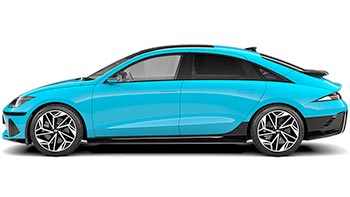
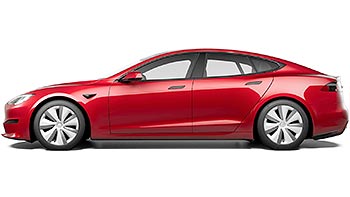
Hyundai Ioniq 6 77.4kWh RWD 2022 - • Tesla Model S Long Range 2021 -
Verdict
The Volkswagen ID.7 Pro is a worthy successor of the famed Volkswagen Passat. It is comfortable and convenient - exactly what a family sedan should be. Its design is inoffensive and suggests what the vehicle is for - going about its daily business without attracting too much attention.
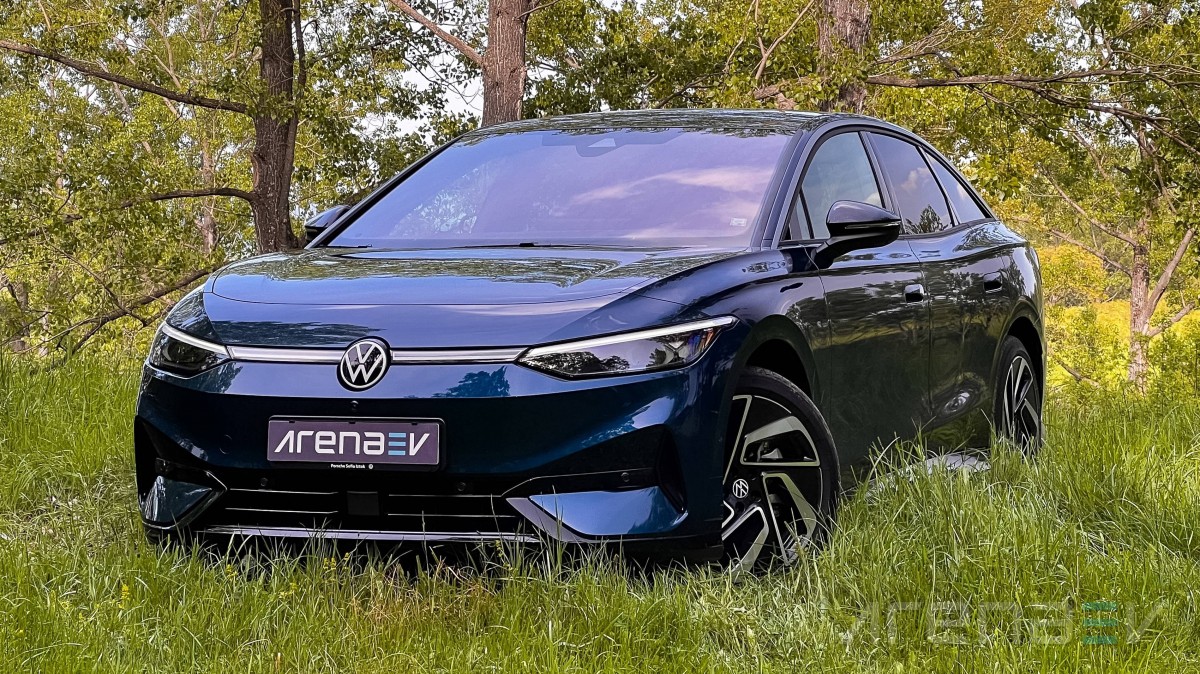
Spending time inside the ID.7 is satisfying as the interior is spacious and well-built, with the ErgoActive seats offering a fantastic mix of comfort and support in corners. There are no major downsides in the ID.7 and its intuitive and modern cabin will undoubtely be well accepted by those looking to get a family sedan.
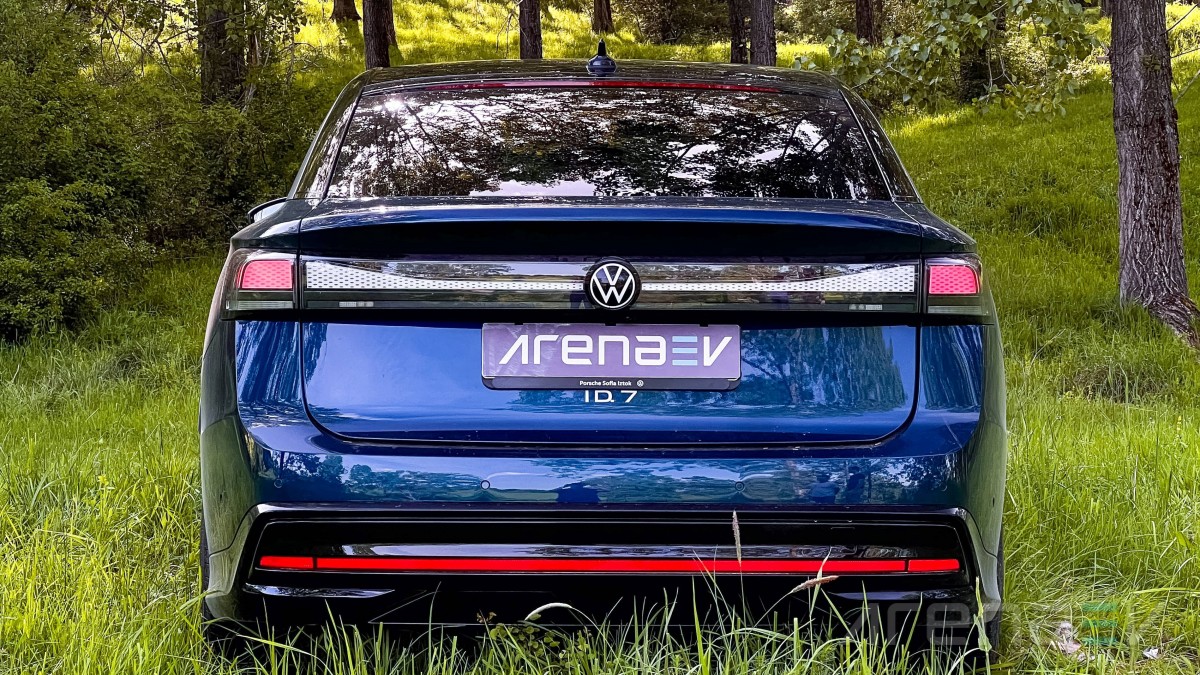
The driving experience of the ID.7 is superb even in the least powerful version and one could only reasonably expect the upcoming more powerful versions to be even better. The whistling wing mirrors and the overcomplicated climate controls are probably its key shortcomings, which is telling as all the important stuff is clearly handled well.

Pros
- Comfortable ride.
- Better infotainment than all other Volkswagen ID models.
- Great efficiency at high speeds.
- Fantastic braking power.
- Supportive and comfy seats.
- Easily maneuverable.
- Stable and communicative driving experience.
- Lots of high-end functions and features.
Cons
- Some squeaky plastics around the interior.
- Overcomplicated A/C controls.
- Adaptive cruise control has to be adjusted through the center screen.
- Speed limit assist is unreliable.
- Annoying wind noise from the wing mirrors at higher speeds.
- Small gauge cluster.
- Haptic feedback buttons are hard to use.
Related
Reader comments
Nothing yet. Be the first to comment.
